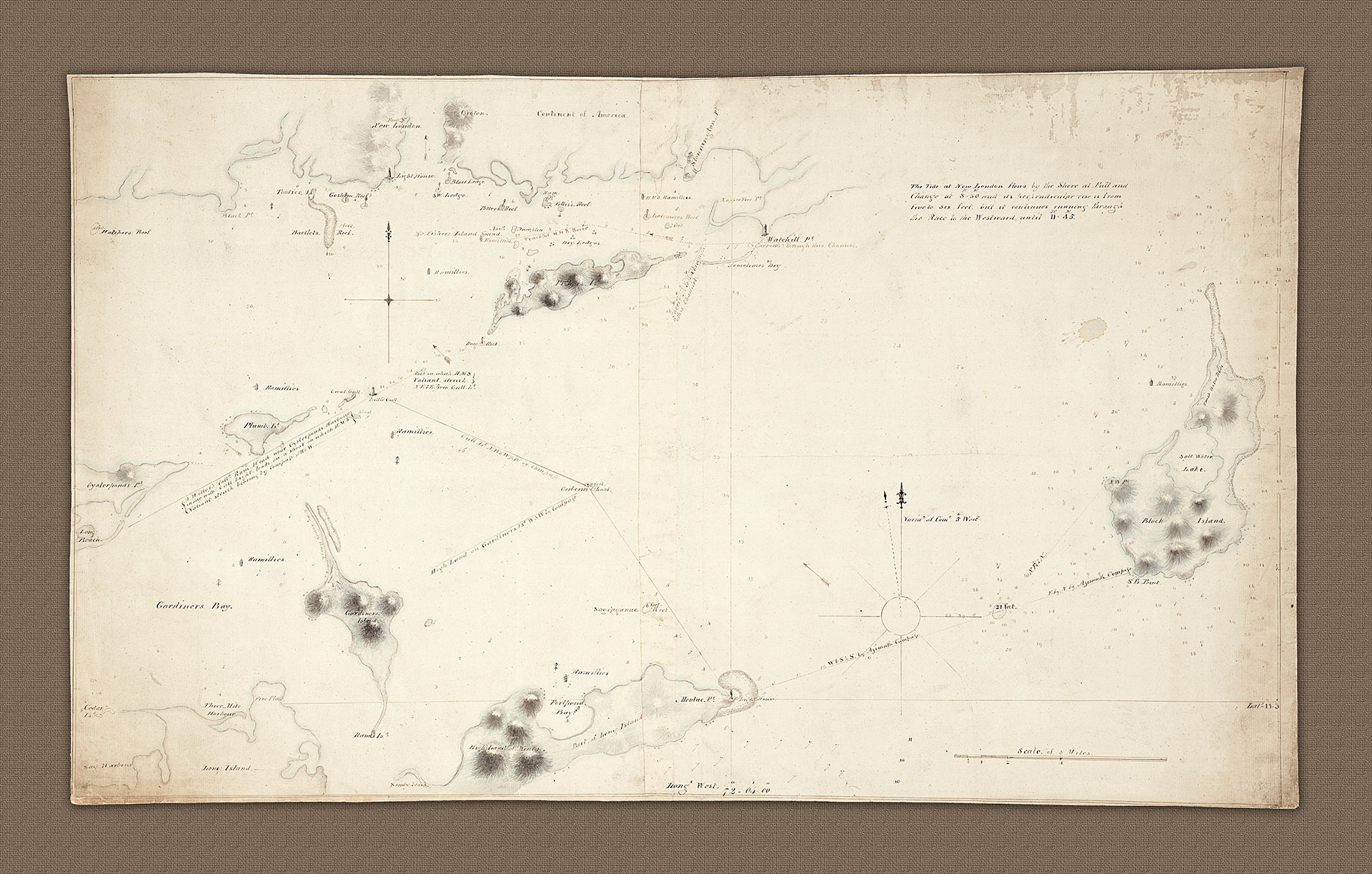
A211 - Block Island, Gardiners Island, Fisher Island & Sound copy
- A fascinating hand-drawn plan which tells the story of the British naval blockade of Long Island Sound during the Anglo-American war of 1812-1815. Despite its simplicity it contains a great deal of information. It was primarily drawn as a hydrographic survey for the benefit the British squadron of ships patrolling the region which was commanded at this time by Sir Thomas Masterman Hardy, previously Admiral Horatio Nelson's Flag Captain at the Battle of Trafalgar in 1805.
- 1813
- Unknown
- h20" x w31.5"
- L
Despite its simplicity this hand-drawn chart contains a great deal of information. It was primarily drawn as a hydrographic survey for the benefit the British squadron of ships patrolling the region which was commanded at this time by Sir Thomas Masterman Hardy, previously Admiral Horatio Nelson's Flag Captain at the Battle of Trafalgar in 1805.
The first thing to note on the chart is that HMS Ramillies is marked on this chart no less than seven times, presumably as the base for survey operations. In addition to detailed soundings the chart includes some important landmarks all of which are as relevant to today's sailors as they were then. These inclusions also help to date the chart.
The depiction of the following lighthouses gives an important clue as to when the chart was drawn, and is one of the earliest records in the region of the development of what we now see as the modern lighthouse.
The lighthouse on Little Gull island overlooked naval activities between the Americans and the British in the vicinity of the Race. It was constructed in 1806 and was 51ft high. The light on was tower was force-ably removed by British marines in 1813 after the lighthouse keeper, Giles Holt, refused to extinguish it.
The lighthouse on Montauk ('Montuk') Point was completed and came into operation in 1796 and was the first public works project of the United States of America.
The New London harbor lighthouse depicted at the mouth of the Thames River, south of New London, was constructed in 1801 and stood 89ft tall. The octagonal brownstone tower still stands and is the oldest existing lighthouse in Connecticut. It was extinguished during the War of 1812 at the request of the American Commander, Commodore Stephen Decatur, Jr., who spent most of the war confined, along with his fleet, by the British in the Thames River.
The light at Watch Hill ('Watchill') Point was reputedly first established to warn local residents of attack from the sea, not as an aid to navigation. The lighthouse depicted here, an 81ft wooden tower, came into operation in 1808. It was Rhode Island's second lighthouse. During his 27 year incumbency, lighthouse keeper Jonathan Nash, recorded 47 wrecks.
Possibly the most telling remark included on the survey is the location of the rock 'on which HMS Valiant struck N E by E from Gull Lt'. This is an important reference to the first naval engagement of the British blockade. In late May 1813 three American ships; USS United States, USS Macedonian and the USS Hornet left New York under the command of Commodore Stephen Decatur, Jr. On the 1st June the three vessels had been forced to take refuge in the Thames River by New London by a powerful British squadron. HMS Valiant had been amongst the British force which had given chase to the three American ships and for her efforts was grounded on the rock and had to wait for high tide to free herself.
The British blockade of Long Island Sound and the wider American coastline proved remorseless and the USS United States and USS Macedonian were kept blocked at New London throughout the duration. The blockade did however provide a couple of noticeable incidents, both involving HMS Ramillies.
The first was an attempt by two New York shippers who, on the 25th June 1813 packed the schooner Eagle with 400 pounds of gunpowder in a cask and other combustibles and sent her down the sound toward HMS Ramillies. They were frustrated by the British blockage and encouraged by a recent Federal statute which effectively offered a reward of half the value of any British ship war (other than those showing a flag of truce, which could be burned sunk or destroyed). The British commander, Sir Thomas Masterman Hardy, possibly recognising the danger, sent a boat out to intercept the intruder. As the British approached the American crew abandoned ship and left the vessel to the British. When the Eagle exploded it killed 11 British seamen. A direct consequence of this act was an edict from the British which effectively declared 'open season' on any and all American vessels, including fishing vessels, operating up and down coast between New York and Halifax.
The second, no less significant, incident was the (further) development of submarine warfare by the American engineer and inventor David Bushnell. Back in 1776 Bushnell had invented the 'Turtle', the first combat submersible. He had used it to attack Admiral Howe's Flagship HMS Eagle in New York harbor. Although the attack had been unsuccessful it had shown that the idea had potential. In 1812, it is believed that David Bushnell built another submarine which attacked the British ship HMS Ramillies at anchor off New London, Connecticut. At least three times the submarine passed under the hull of the Ramillies but again failed to attach the explosive charge. A Connecticut newspaper editor reported that; 'So great is the alarm and fear aboard the Ramillies that Commodore Hardy keeps his ships under way at all times'.
This apparrently simple survey is an excellent example of the importance of really looking at what is not written on the chart.
- Block Island, Gardiners Island, Fisher Island & Sound copy


